Understanding fluid measurements is crucial for a variety of everyday tasks, from cooking and baking to scientific experiments and industrial applications. One common question that arises is how many ounces are in a gallon. This article aims to clarify this conversion, discuss the differences between various measurement systems, and provide practical applications for this knowledge. By the end, you’ll have a comprehensive understanding of fluid measurements and how to convert between ounces and gallons accurately.
Key Takeaway Section
Summary of Key Points
- Understanding fluid measurements is essential for various tasks.
- There are 128 fluid ounces in a US gallon and 160 fluid ounces in an Imperial gallon.
- Accurate conversions are important for cooking, scientific experiments, and more.
Understanding Fluid Measurements
Fluid measurements are essential in many aspects of daily life. Whether you’re following a recipe, measuring fuel, or conducting a scientific experiment, knowing how to convert between different units of measurement is vital. The most common units for measuring fluids include ounces, pints, quarts, and gallons. Each unit serves a specific purpose and is used in different contexts.
Overview of Fluid Measurements
Fluid measurements are categorised into various units, each serving specific functions. The most frequently used units include:
- Ounces: Commonly used for smaller quantities of liquid, such as beverages and ingredients in cooking.
- Pints: Often used in recipes and for measuring smaller containers of liquids.
- Quarts: Used for larger quantities of liquid, such as milk containers and large recipes.
- Gallons: Typically used for even larger volumes, such as fuel and bulk liquids.
Understanding these units and their conversions is essential for accurate measurement in both everyday and professional contexts.
Ounces to Gallons Conversion
One of the most important conversions to understand is how many ounces are in a gallon. This knowledge is useful in various scenarios, from kitchen measurements to industrial applications.
Detailed Conversion Formula
To convert ounces to gallons, it’s important to know that there are 128 fluid ounces in a US gallon. The formula for this conversion is straightforward:
Gallons=Ounces128\text{Gallons} = \frac{\text{Ounces}}{128}Gallons=128Ounces
For example, if you have 256 ounces, you can convert this to gallons by dividing 256 by 128, which equals 2 gallons.
Common Uses for This Conversion
Understanding the ounces-to-gallons conversion is useful in many situations:
- Cooking and Baking: Converting recipes that list ingredients in ounces but require larger quantities measured in gallons.
- Science and Industry: Measuring chemicals or other fluids where large volumes need to be converted into smaller, manageable units.
- Everyday Use: Estimating the amount of fuel needed for a trip or how much a container can hold.
Variations in Measurements
Different measurement systems can complicate fluid conversions, especially when dealing with international recipes or products. The two primary systems are the US customary system and the Imperial system.
Imperial vs. US Measurement Systems
The US and Imperial measurement systems differ in their definitions of gallons and fluid ounces. In the US system, a gallon is 128 fluid ounces, while in the Imperial system, a gallon is 160 fluid ounces. This discrepancy can lead to confusion when converting measurements.
Practical Applications
Knowing how to convert fluid measurements is valuable in various real-world scenarios. From cooking to industrial applications, accurate measurements are crucial.
Real-World Scenarios
- Cooking: When scaling recipes up or down, converting fluid measurements ensures consistency and accuracy.
- Fuel Calculations: Estimating fuel needs for vehicles or equipment often requires converting gallons to ounces or vice versa.
- Scientific Experiments: Precise fluid measurements are essential for accurate results in experiments.
Tools and Resources
Several tools and resources can aid in fluid conversions:
- Conversion Apps: Smartphone apps can quickly convert fluid measurements.
- Online Calculators: Websites offer easy-to-use conversion calculators.
- Measurement Charts: Printable charts provide quick references for common conversions.
Importance of Accurate Measurement
Accurate fluid measurements ensure consistency and success in various applications, from recipes to industrial processes. Mistakes in conversion can lead to incorrect results, wasted resources, and even safety hazards.
Final Tips
- Always double-check your conversions, especially when dealing with different measurement systems.
- Use reliable tools and resources to ensure accuracy.
- Practice converting measurements to become more familiar with the process.
Conclusion
Final Thoughts
Understanding how many ounces are in a gallon and the importance of accurate fluid measurements is essential for many everyday and professional tasks. By mastering these conversions, you can ensure precision and efficiency in your work and daily life. Utilise the tools and tips provided to make fluid measurements straightforward and accurate.


